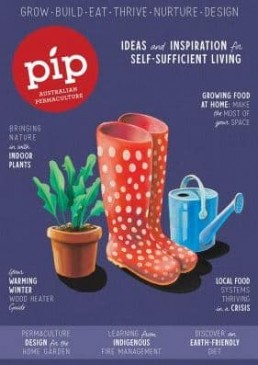Permaculture title Pip magazine is a print success story to come out of 2020. Founder and Publisher Robyn Rosenfeldt explains how Pip’s strong online presence helped to triple magazine sales over Australia’s COVID-19 lockdown period, paving the way for the magazine to increase its print editions.
Despite 2020 seeing the closure of some print magazines and newspapers, niche publications – especially those with a sustainable lifestyle focus – have been growing. Australia’s sustainability and permaculture lifestyle title, Pip magazine, which has been in publication since 2014, is a good example of this.
Pip magazine sales during the first month of Australia’s lockdown increased by 300 per cent, and its overall subscription numbers increased by 150 per cent. Retail sales increased by 20 per cent despite interruptions to airport newsagencies.

The increased reader and buyer interest in Pip magazine’s print and digital content has resulted in Founder and Publisher Robyn Rosenfeldt taking on more staff and investing in new systems and processes to increase the number of magazine issues from its current three-edition distribution. From 2021, the magazine will be available via four editions, out in February, May, August and November.
Not only that, Pip has just been announced as a finalist in the Mumbrella Publish 2020 Awards in the coveted Publishing Company of the Year category. NPN Editor Lyndsie Clark caught up with Rosenfeldt to chat about starting a magazine with little publishing experience, using a multi-platform approach to drive magazine growth, and what it really means to build an authentic brand.
Nearly nine in 10 of these media properties have an audience size of less than 500,000 people visiting per month and three-quarters have an audience size of less than 250,000 people per month. “These small and medium digital publishers play a vital role in providing specific content and community connection to consumers that may not be otherwise provided by larger media brands. They also present a huge opportunity to advertisers.” – IAB Australia
Gai Le Roy, CEO of IAB Australia commented: “One of our key objectives is to help support a sustainable and diverse digital media and advertising market. We are delighted to share these new resources specifically developed for smaller publishers who are evolving digital ad offerings and exploring different revenue models. “The passion and commitment of these smaller publishers to finding sustainable ways of serving and informing our communities will bring a rich and important chorus of voices across their channels. “Although there has always been a rich fabric of small and mid-sized publishers, we are excited to see a range of new titles servicing regional areas as well as other site, apps and podcasts servicing particular niche audiences,” she said.
IAB Australia is the peak trade association for online advertising in Australia. The IAB has also announced a new membership rate to make IAB research, resources, briefings and mentorship programs more cost-effective for smaller publishers. The New & Niche Publishers Guide to Digital Advertising guide can be downloaded here.
Setting the picturesque scene: how Pip magazine began
Today, Rosenfeldt produces Pip magazine from her two and a half acre property in Pambula, New South Wales, with a small team of staff and freelancers that work either in her converted-barn office or remotely. But when Pip first began, it was just Rosenfeldt. Rosenfeldt fell into magazine publishing after a career as a freelance photographer and journalist.
“I was a photographer to begin with,” she explains “I did lots of travel photography. I’d travel, and take photos, then come home and try to get them published. But often I’d be told that an article was needed to accompany the photos. So I taught myself how to write, did a few courses, and became a freelance journalist.” It was this learn-while-doing attitude that led Rosenfeldt to start Pip magazine. “I’d always had an interest in gardening and growing food and permaculture,” says Rosenfeldt. After making the tree change to Pambula from Melbourne, she got the opportunity to edit a local magazine about sustainability.
“I found that I could use my photography and writing skills, and focus on my interest in sustainability. I was able to bring them all together in one place. And I loved it.” – Robyn Rosenfeldt, Publsiher, Pip magazine
Rosenfeldt did a permaculture course and realised that there was no permaculture magazine in Australia, despite the principles originating in Australia. “So I decided to start a permaculture magazine. I was seven months pregnant at the time, and I had two other small kids. So I let the idea brew for a while. Then I started it a couple of years later, with three kids under six.”
Pip was originally funded through a crowdfunding campaign. Enough money was raised to pay for the first print run, which meant that Rosenfeldt could make Pip a reality without starting in debt. Pledges came in from over 270 supporters, many of who still subscribe to the magazine today. While Rosenfeldt had some experience editing the local sustainability magazine, she’d never worked in a publishing environment before.
“I kind of just made that up as I went along and maybe didn’t know the full extent of what was involved, which might have been a good thing,” she laughs. “There are so many different aspects of a magazine. There’s so much you’ve got to keep your head around: you’re the publisher, the editor, the manager, the hirer, and the computer tech person.” Rosenfeldt says that her small but dynamic network of staff, contractors and freelancers is incredibly helpful in putting together the magazine’s print and online content. The end result is a visually beautiful magazine that is produced to be treasured and revisited, reaching over 56,000 print readers with practical and accessible content about living a sustainable life using permaculture principles.
Source : Target Media Services
